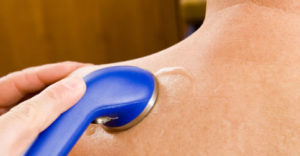Therapeutic Ultrasound
Therapeutic ultrasound is a modality that has been used by physiotherapists since the 1940s. Ultrasound is applied using the head of an ultrasound probe that is placed in direct contact with your skin via a transmission coupling gel. It is used to provide deep heating to soft tissues in the body. These tissues include muscles, tendons, joints, and ligaments. Ultrasound in physical therapy is not to be confused with diagnostic ultrasound, which is an ultrasound that is used to see the inside of the body, such as checking on a fetus during pregnancy.
 What Does Ultrasound Do?
What Does Ultrasound Do?
Therapeutic ultrasound is used primarily for two different effects: the deep heating treatment and non-thermal uses.
Deep Heating Effects: Ultrasound is often used to provide deep heating to soft tissue structures in the body. Deep heating tendons, muscles or ligaments increases circulation to those tissues, which is thought to help the healing process. Increasing tissue temperature with ultrasound is also used to help decrease pain.
Deep heating can be used to increase the “stretchiness” of muscles and tendons that may be tight. If you have shoulder pain and have been diagnosed with a frozen shoulder, your physical therapist may use ultrasound to help improve the extensibility of the tissues around your shoulder prior to performing range of motion exercises. This may help improve the ability of your shoulder to stretch.
Non-Thermal Effects (Cavitation): Ultrasound introduces energy into the body. This energy causes microscopic gas bubbles around your tissues to expand and contract rapidly, a process called cavitation. It is theorized that the expansion and contraction of these bubbles help speed cellular processes and improves healing of injured tissue.
Two types of cavitation include stable and unstable cavitation. Stable cavitation is desired when your physical therapist is applying ultrasound to your body. Unstable cavitation can be dangerous to your body’s tissues, and your physical therapist will ensure that this does not occur during the application of ultrasound.
How Does Ultrasound Work?
Inside the ultrasound unit is a small crystal. When an electrical charge is applied to this crystal, it vibrates rapidly, creating piezoelectric waves. These waves are emitted from the ultrasound sound head as ultrasound waves. The ultrasound wave then enters into your injured tissues during application of the modality. This increases blood flow and caviation, leading to the theorized benefits of the treatment.
How Is Ultrasound Applied?
Ultrasound is performed with a machine that has an ultrasound transducer (sound head). A small amount of gel is applied to the particular body part; then your physical therapist slowly moves the sound head in a small circular direction on your body. The therapist may change various settings on the ultrasound unit to control the depth of penetration of the ultrasound waves or change the intensity of the ultrasound. Different settings are used in various stages of healing.
Common Injuries Treated with Ultrasound
Usually, orthopedic injuries are treated with ultrasound. These may include:
- Bursitis
- Tendonitis
- Muscle strains and tears
- Frozen shoulder
- Sprains and ligament injuries
- Joint contracture or tightness
Generally speaking, any soft-tissue injury in the body may be a candidate for ultrasound therapy.

 What Does Ultrasound Do?
What Does Ultrasound Do?